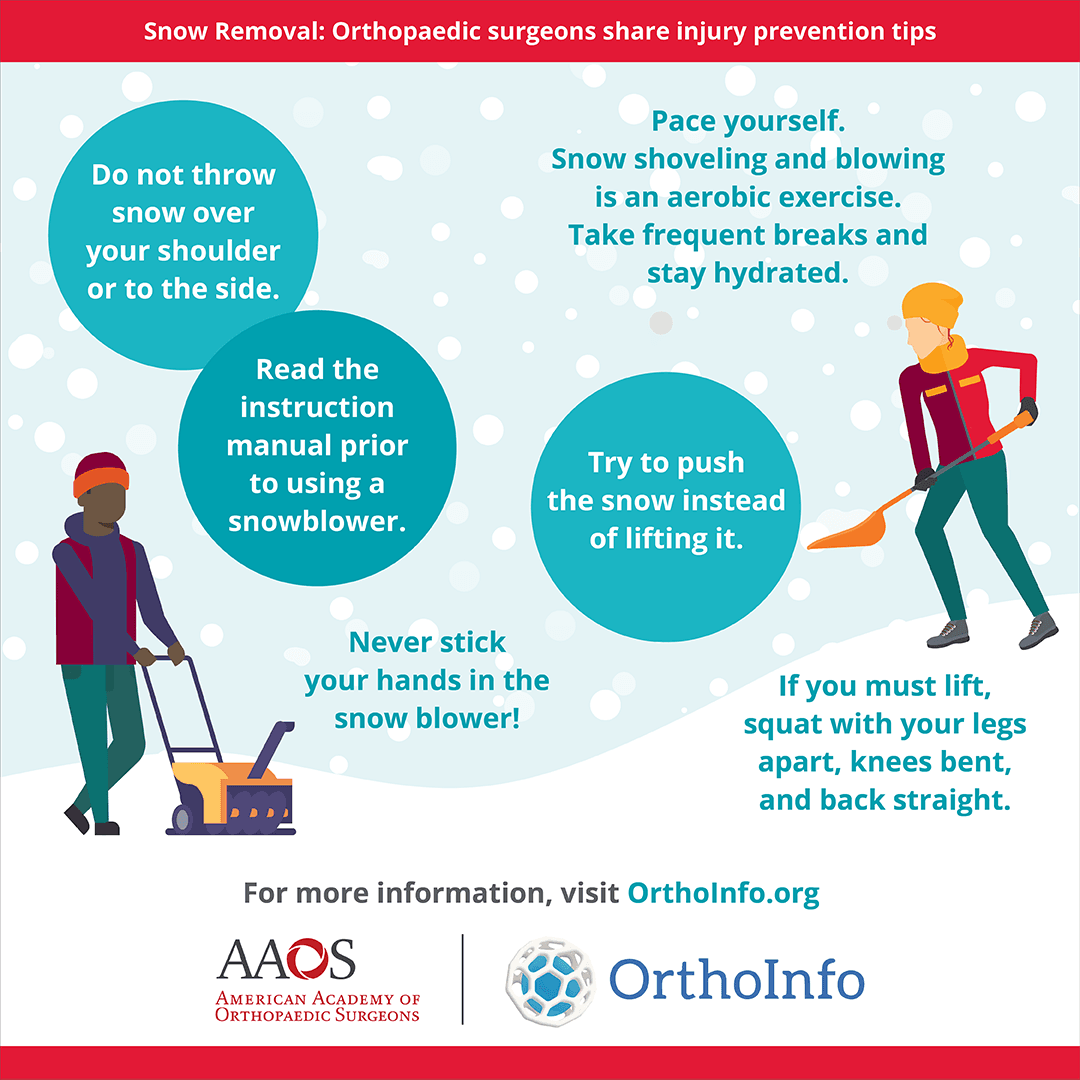Staying Healthy
Prevent Snow Shoveling and Snowblowing Injuries
Snow removal is more than just another necessary household chore. All that bending and lifting of heavy snow can put you at serious risk for orthopaedic injury and place undue stress on your heart. Snow removal can be especially dangerous if you do not exercise regularly.
According to the U.S. Consumer Product Safety Commission, in 2018, more than 137,000 people were treated in emergency rooms, doctors' offices, and clinics for injuries that happened while shoveling or using snowblowers.
The most common injuries associated with snow removal include sprains and strains, particularly in the back and shoulders, as well as lacerations and finger amputations.
General Tips for Safe Snow Clearing
- Dress appropriately. Light, layered, water-repellent clothing provides both ventilation and insulation. It is also important to wear the appropriate head covering and thick, warm socks. Choose gloves or mittens that will keep your hands warm, dry, and blister-free. Avoid falls by wearing shoes or boots that have slip-resistant soles.
- Start early. Try to clear snow early and often—particularly if a large snowfall is expected. It is always best to begin shoveling/snowblowing when there is just a light covering of snow on the ground. Starting early will give you the best chance possible to avoid the potential injuries that come with moving packed, heavy snow.
- Make sure you can see. Be sure that you can fully see the area that you are shoveling/snowblowing. Do not let a hat or scarf block your vision. Watch for ice patches and uneven surfaces.
- Check with your doctor if you have any medical problems. Clearing snow places a great deal of stress on the heart—so if you have a medical condition or do not exercise regularly, you should speak with your doctor before shoveling or snow blowing. You may also wish to consider hiring someone to remove the snow, rather than doing it yourself.
Tips for Snow Shoveling
- Warm up your muscles. Shoveling can be a vigorous activity. Before you begin this physical workout, warm up your muscles for 10 minutes with light exercise.
- Pace yourself. Snow shoveling and snow blowing are aerobic activities. Take frequent breaks and prevent dehydration by drinking plenty of fluids. If you experience chest pain, shortness of breath, or other signs of a heart attack, stop the activity and seek emergency care.
- Proper equipment. Use a shovel that is comfortable for your height and strength. Do not use a shovel that is too heavy or too long for you. Space your hands on the tool grip to increase your leverage.
- Proper lifting. Try to push the snow instead of lifting it. If you must lift, do it properly. Squat with your legs apart, knees bent, and back straight. Lift with your legs. Do not bend at the waist. Scoop small amounts of snow into the shovel and walk to where you want to dump it. Holding a shovelful of snow with your arms outstretched puts too much weight on your spine. Never remove deep snow all at once—this is particularly important in the case of heavy, wet snow. Do it in pieces.
- Safe technique. Do not throw the snow over your shoulder or to the side. This requires a twisting motion that stresses your back.
Tips for Snowblowing
- Never stick your hands in the snowblower. If snow jams the snowblower, stop the engine and wait more than 5 seconds. Use a solid object to clear wet snow or debris from the chute. Beware of the recoil of the motor and blades after the machine has been turned off.
- Proper supervision. Do not leave the snow blower unattended when it is running. Shut off the engine if you must walk away from the machine.
- Safe fueling. Add fuel before starting the snowblower. Never add fuel when the engine is running or hot. Be sure to always fuel your snowblower outside—rather than in a garage, shed, or enclosed area—to avoid being overwhelmed by engine fumes. Never operate the machine in an enclosed area.
- Avoid the engine. Stay away from the engine. It can become very hot and burn unprotected flesh.
- Use the pull-cord safely. To start a machine with a pull-cord, hold the cord firmly and stand with feet wide apart in a broad stance. If the cord does not move freely, do not force it. Sharply pulling a nonmoving pull-cord may cause an injury to your upper body or back.
- Watch the snowblower cord. If you are operating an electric snow blower, be aware of where the power cord is at all times. If the cord becomes caught in the machine and is severed, or comes in contact with the engine and burns, you could receive a shock or become electrocuted.
- No tampering. Do not remove safety devices, shields, or guards on switches, and keep hands and feet away from moving parts.
- Watch for motor recoil. Beware of the brief recoil of motor and blades that occurs after the machine has been turned off.
- Keep children away. Never let children operate snowblowers. Keep children 15 years of age and younger away when snowblowers are in use.
- Understand your machine. Read the instruction manual prior to using a snowblower. Be familiar with the specific safety hazards and unfamiliar features. Do not attempt to repair or maintain the snowblower without reading the instruction manual.
AAOS does not endorse any treatments, procedures, products, or physicians referenced herein. This information is provided as an educational service and is not intended to serve as medical advice. Anyone seeking specific orthopaedic advice or assistance should consult his or her orthopaedic surgeon, or locate one in your area through the AAOS Find an Orthopaedist program on this website.







